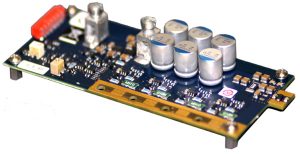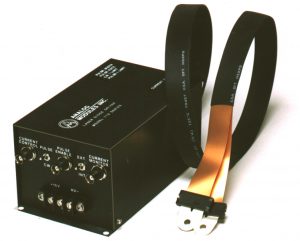AMI offers a variety of laser diode drivers for applications from short pulse fiber lasers to high power directed energy systems. 
Two Power Sources
Customers often have questions about the need for two power supplies for many of our OEM drivers. Separate power sources are needed to power the control electronics and to power the laser drive.
Control Power
 The voltage needed varies by driver; the power consumed by the control electronics is low. AMI’s Model 779A requires +11 to +16 VDC at 30mA ; our Model 7701A’s control board is powered by either 110 or 220 VAC, 1 Ø, 50/60Hz power. It is best to apply the control voltage prior to drive power. AMI’s drivers have safeguards to prevent output to the load when the control circuits are not active. It is best not to test these safety measures; unplanned laser emission are to be avoided.
The voltage needed varies by driver; the power consumed by the control electronics is low. AMI’s Model 779A requires +11 to +16 VDC at 30mA ; our Model 7701A’s control board is powered by either 110 or 220 VAC, 1 Ø, 50/60Hz power. It is best to apply the control voltage prior to drive power. AMI’s drivers have safeguards to prevent output to the load when the control circuits are not active. It is best not to test these safety measures; unplanned laser emission are to be avoided.
Drive Power
The laser drive power source will need to provide enough voltage for the drops across the laser diode and the driver; for long pulse width applications (≥1 ms) additional voltage may be needed to account for voltage droop during the output pulse. The power required is the average power of the output to the load (voltage * current * duty cycle) plus the power dropped across the driver (voltage loss * drive current * duty cycle). The voltage drop can be calculated; however it is best to monitor the differential voltage while operating.
AMI is here to help
When selecting the best diode driver or integrating that driver into your system we are happy to provide assistance. AMI can simulate your operating conditions using tools we have developed over our decades of experience to determine your specific power requirements.

Please contact AMI today to discuss your laser diode drive requirements.
AMI offers OEM Diode Drivers for the following applications:

 sales@analogmodules.com
sales@analogmodules.com 1-407-339-4355
1-407-339-4355





 Hybrid eyesafe laser rangefinder receiver is designed for laser rangefinding & surveying equipment. Compact construction is ideal for miniature applications. Fast recovery from To overload allows ranging to close objects without compromising long range performance. The incorporation of an InGaAs APD gives very high sensitivity with time programmed gain to minimize false targets. Operation at both 1.06 µm and 1.54 µm is possible over a wide range of pulse widths.
Hybrid eyesafe laser rangefinder receiver is designed for laser rangefinding & surveying equipment. Compact construction is ideal for miniature applications. Fast recovery from To overload allows ranging to close objects without compromising long range performance. The incorporation of an InGaAs APD gives very high sensitivity with time programmed gain to minimize false targets. Operation at both 1.06 µm and 1.54 µm is possible over a wide range of pulse widths.
